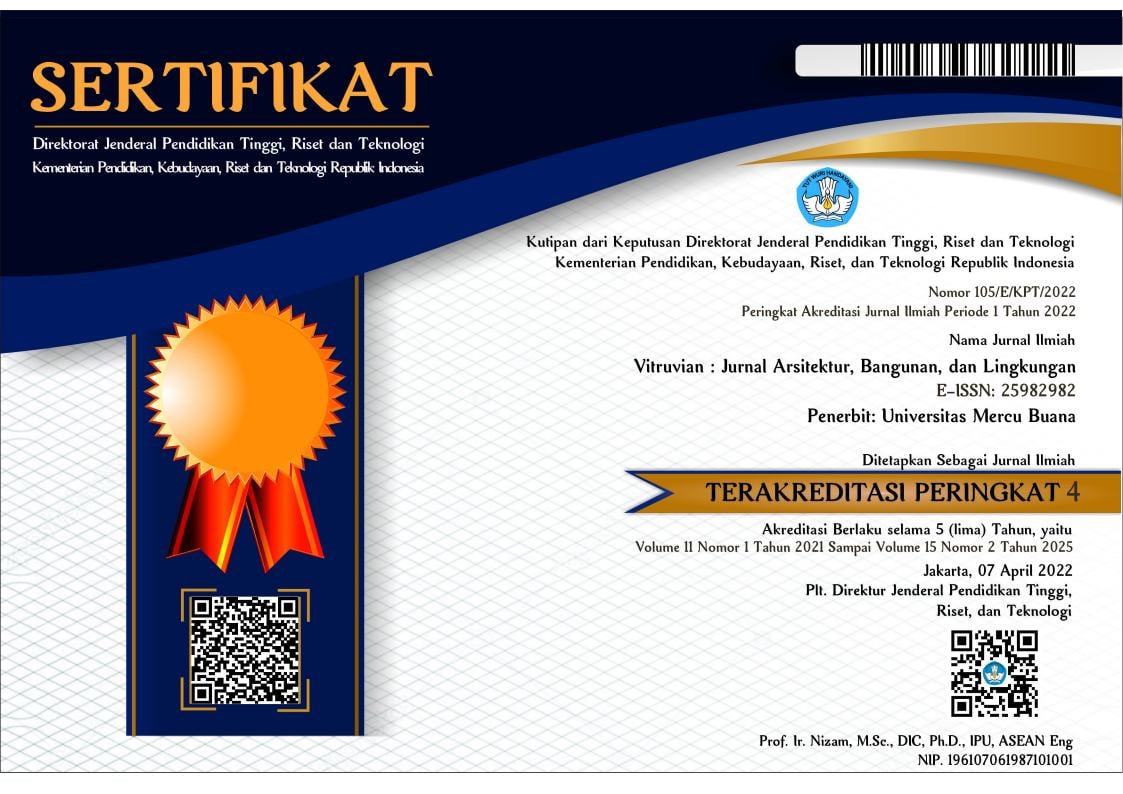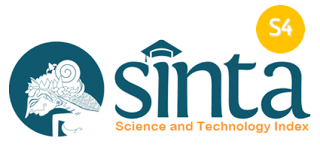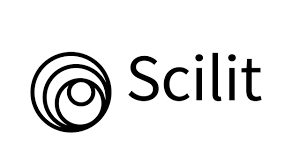PENGEMBANGAN METODE PEMBELAJARAN VIRTUAL REALITY UNTUK MAHASISWA ARSITEKTUR TAHUN PERTAMA
Abstract
Virtual Reality (VR) berkembang sangat pesat dan menjadi teknologi yang semakin populer dalam beberapa tahun terakhir. Manfaatnya di bidang arsitektur mencakup aspek yang luas: desain dan pengembangan, presentasi dan komunikasi, pembelajaran dan pelatihan, hingga evaluasi dan pengujian. Arsitek masa depan penting untuk mengenal konsep kerja VR supaya dapat mengintegrasikan pemanfaatan teknologi ini dalam proses perancangan mereka, namun sejauh ini belum ada yang mengkaji metode pembelajaran khusus yang mudah diadaptasi bagi mahasiswa pemula. Penelitian ini bertujuan untuk mengembangkan model pembelajaran teknologi VR yang cocok bagi mahasiswa arsitektur tahun pertama. Menggunakan metode penelitian pengembangan ADDIE, data dikumpulkan melalui observasi, wawancara, dan analisis isi. Studi kasus digunakan untuk mengevaluasi metode pembelajaran VR yang dipilih, melibatkan dosen dan 172 mahasiswa sebagai responden. Berdasar analisis awal, Software Enscape for Sketchup paling sesuai untuk digunakan. Karya 33 kelompok dianalisis untuk mengevaluasi efektivitas model pembelajaran dalam meningkatkan pemahaman dan keterampilan mahasiswa dalam menggunakan teknologi VR untuk presentasi arsitektural. Hasil menunjukkan bahwa model pembelajaran yang dikembangkan dapat meningkatkan pemahaman konsep kerja VR dan kebermanfaatannya dalam mempresentasikan ruang dan desain arsitektur secara lebih efektif, efisien, realistis dan interaktif. Namun, walau Enscape telah menawarkan 4 jenis VR yang dapat dihasilkan, masih terdapat beberapa kendala yang perlu diperhatikan dalam pembelajaran berikutnya, seperti masalah teknis, kecukupan waktu untuk mengeksplorasi, serta keterbatasan hardware komputer yang digunakan.
Keywords
Full Text:
PDF (Bahasa Indonesia)References
Aseeri, S., Paraiso, K., & Interrante, V. (2019a). Investigating the influence of virtual human entourage elements on distance judgments in virtual architectural interiors. Frontiers Robotics AI, 6(JUN), 44. https://doi.org/10.3389/frobt.2019.00044
Aseeri, S., Paraiso, K., & Interrante, V. (2019b). Investigating the influence of virtual human entourage elements on distance judgments in virtual architectural interiors. Frontiers Robotics AI, 6(JUN). https://doi.org/10.3389/FROBT.2019.00044
Balzerkiewitz, H. P., & Stechert, C. (2020). THE EVOLUTION of VIRTUAL REALITY towards the USAGE in EARLY DESIGN PHASES. Proceedings of the Design Society: DESIGN Conference, 1, 91–100. Cambridge University Press. https://doi.org/10.1017/dsd.2020.159
Bashabsheh, A. K., Alzoubi, H. H., & Ali, M. Z. (2019). The application of virtual reality technology in architectural pedagogy for building constructions. Alexandria Engineering Journal, 58(2), 713–723. https://doi.org/10.1016/j.aej.2019.06.002
Beck, J., Rainoldi, M., & Egger, R. (2019). Virtual reality in tourism: a state-of-the-art review. Tourism Review, 74(3), 586–612. https://doi.org/10.1108/TR-03-2017-0049/FULL/XML
Bingham, K., & Porter, G. (2021). The Preparedness of Master of Architecture Graduates for the Fourth Industrial Revolution (4IR). Energy Water, (December), 154–163.
Brůha, L., Laštovička, J., Palatý, T., Štefanová, E., & Štych, P. (2020). Reconstruction of lost cultural heritage sites and landscapes: context of ancient objects in time and space. ISPRS International Journal of Geo-Information, 9(10), 604. https://doi.org/10.3390/ijgi9100604
Cahyadi, R. A. H. (2019). Pengembangan Bahan Ajar Berbasis Addie Model. Halaqa: Islamic Education Journal, 3(1), 35–42. https://doi.org/10.21070/halaqa.v3i1.2124
Chaos Enscape. (2022). Architectural Virtual Reality | VR Rendering | EnscapeTM. Retrieved March 29, 2023, from https://enscape3d.com/features/architectural-virtual-reality/
Chaos Enscape. (2023). Enscape Free Sample Projects. Retrieved March 29, 2023, from https://enscape3d.com/free-sample-projects/
Chowdhury, S., & Hanegraaf, J. (2022). Co-presence in Remote VR Co-design: Using Remote Virtual Collaborative Tool Arkio in Campus Design. Proceedings of the 27th Conference on Computer Aided Architectural Design Research in Asia (CAADRIA) [Volume 2], 2, 465–474. https://doi.org/10.52842/conf.caadria.2022.2.465
ČISAR, P., & MARAVIĆ ČISAR, S. (2020). Development concepts of virtual reality software. ACTA TECHNICA CORVINIENSIS – Bulletin of Engineering, 13(3), 23–29.
Combes, B., Nassiry, D., Fitzgerald, L., & Moussa, T. (2017). Emerging and exponential technologies : New opportunities for low-carbon development. London: CDKN, (November), 1–32.
Cruz, A., Paredes, H., Morgado, L., & Martins, P. (2021). Non-verbal aspects of collaboration in virtual worlds: A cscw taxonomy-development proposal integrating the presence dimension. Journal of Universal Computer Science, 27(9), 913–954. https://doi.org/10.3897/JUCS.74166
Diemer, J., Alpers, G. W., Peperkorn, H. M., Shiban, Y., & Mühlberger, A. (2015). The impact of perception and presence on emotional reactions: A review of research in virtual reality. Frontiers in Psychology, 6(JAN), 26. https://doi.org/10.3389/FPSYG.2015.00026/BIBTEX
Donny, A., Mahendra, K., Wedi, A., Husna, A., & History, A. (2022). Pengembangan Desktop Virtual Reality Arsitektur Dan Seni Bangunan Peninggalan Hindu-Buddha Di Indonesia. JKTP: Jurnal Kajian Teknologi Pendidikan, 5(4), 412–422. https://doi.org/10.17977/UM038V5I42022P412
Dörner, R., & Steinicke, F. (2013). Wahrnehmungsaspekte von VR. Springer Vieweg, Berlin, Heidelberg. https://doi.org/10.1007/978-3-642-28903-3_2
Eloy, S., Kreutzberg, A., & Symeonidou, I. (2021). Virtual aesthetics in architecture: Designing in mixed realities. In Virtual Aesthetics in Architecture: Designing in Mixed Realities. Routledge. https://doi.org/10.4324/9781003183105
Enscape, C. (2022). Lighting - Enscape. Retrieved March 29, 2023, from https://learn.enscape3d.com/blog/knowledgebase/sketchup_lighting/
Fahmi, M. R., Putra, A. K., & Handoyo, B. (2022). Development of Web-Based Virtual Reality as Media Learning for Baluran Conservation Area with Geographical Characteristics. Proceedings of the 2nd International Conference on Social Knowledge Sciences and Education (ICSKSE 2022), 332–346. Paris: Atlantis Press. https://doi.org/10.2991/978-2-494069-63-3_30
Fazar, A. R., Usman, A., & Budiman, A. (2023). Pembuatan Iklan Marketing Interior Rumah Menggunakan Sketchup 3D Berbasis Panorama 360. JurnalIlmuKomputerdanSistem Informasi (JIRSI), 2(1), 145–157.
Guttentag, D. A. (2010). Virtual reality: Applications and implications for tourism. Tourism Management, 31(5), 637–651. https://doi.org/10.1016/J.TOURMAN.2009.07.003
Huff Eckert, V., Curran, C., & Bhardwaj, S. C. (2016). Tech breakthroughs megatrend: how to prepare for its impact. Pwc, 18.
Januszewski, A., & Molenda, M. (2008). Technology: A Definition With Commentary. New York: Lawrence Erlbaum Associates.
Junaedi, A., dkk. (2020). Panduan Penyusunan Kurikulum Pendidikan Tinggi Di Era Industri 4.0 Untuk Mendukung Merdeka Belajar-Kampus Merdeka, Jakarta: Direktorat Pembelajaran dan Kemahasiswaan, Direktorat Jenderal Pendidikan Tinggi, Kementerian Pendidikan dan Kebudayaan. In Kementerian Pendidikan dan Kebudayaan. Direktorat Jenderal Pendidikan Tinggi.
Khodeir, L. M., & Nessim, A. A. (2020). Changing skills for architecture students employability: Analysis of job market versus architecture education in Egypt. Ain Shams Engineering Journal, 11(3), 811–821. https://doi.org/10.1016/j.asej.2019.11.006
Kurnia Putra, A., Handoyo, B., Naufal Islam, M., & Sumarmi, S. (2022). Pengembangan media inovatif Virtual field trips berbasis Geospatial technology dalam pembelajaran post-pandemi Covid-19. In Pendidikan Karakter dan Ilmu Pengetahuan Menyongsong Era Society 5.0 (pp. 3–14). Malang: Universitas Negeri Malang.
Kwegyir-Afful, E., Hassan, T. O., & Kantola, J. I. (2022). Simulation-based assessments of fire emergency preparedness and response in virtual reality. International Journal of Occupational Safety and Ergonomics, 28(2), 1316–1330. https://doi.org/10.1080/10803548.2021.1891395
Lens Scholarly Search. (2023). Retrieved November 29, 2023, from https://www.lens.org/lens/search/scholar/list?collectionId=200757
Likens, S. (PWC). (2022). The Essential Eight technology trends: PwC. Retrieved March 29, 2023, from PWC Emerging Technologies website: https://www.pwc.com/us/en/tech-effect/emerging-tech/essential-eight-technologies.html
Lombard, M., & Ditton, T. (1997, September 1). At the heart of it all: The concept of presence. Journal of Computer-Mediated Communication, Vol. 3. Wiley Blackwell. https://doi.org/10.1111/j.1083-6101.1997.tb00072.x
Lovreglio, R., Duan, X., Rahouti, A., Phipps, R., & Nilsson, D. (2021). Comparing the effectiveness of fire extinguisher virtual reality and video training. Virtual Reality, 25(1), 133–145. https://doi.org/10.1007/s10055-020-00447-5
Majumder, Md. A. A., Sa, B., Alateeq, F. A., & Rahman, S. (2019). Teaching and Assessing Critical Thinking and Clinical Reasoning Skills in Medical Education. In https://services.igi-global.com/resolvedoi/resolve.aspx?doi=10.4018/978-1-5225-7829-1.ch012 (pp. 213–233). IGI Global. https://doi.org/10.4018/978-1-5225-7829-1.ch012
Obeid, S., & Demirkan, H. (2020). The influence of virtual reality on design process creativity in basic design studios. Interactive Learning Environments. https://doi.org/10.1080/10494820.2020.1858116
Okechukwu, M., & Udoka, F. (2011). Understanding Virtual Reality Technology: Advances and Applications. In Advances in Computer Science and Engineering. IntechOpen. https://doi.org/10.5772/15529
Pellas, N., Mystakidis, S., & Kazanidis, I. (2021). Immersive Virtual Reality in K-12 and Higher Education: A systematic review of the last decade scientific literature. Virtual Reality, 25(3), 835–861. https://doi.org/10.1007/s10055-020-00489-9
Sawyer, A. O., & Xie, J. (2022). Shaping Light: An Integrative Approach to Teaching Lighting Design in Architecture. (September).
Schumacher, P. (2022). The metaverse as opportunity for architecture and society: design drivers, core competencies. Architectural Intelligence, 1(1), 1–20. https://doi.org/10.1007/s44223-022-00010-z
Setiadi, W., & Purwanto, L. M. F. (2021). Teknologi Digital pada Pendidikan Arsitektur di Era Industri 4.0. JoDA Journal of Digital Architecture, 1(1), 42. https://doi.org/10.24167/joda.v1i1.3681
Setyaningfebry, F., Felasari, S., & Michelle, B. (2023). Developing a website for rendering based on renderers’ experience. Grafica, 11(21), 23–36. https://doi.org/10.5565/rev/grafica.235
Shahril, M. I. Bin, Salimin, N. Bin, & Elumalai, G. a/l. (2015). The Validity and Reliability of ISO Test towards the Performance Assessment of Future Physical Education Teachers in Teaching and Learning Process. Procedia - Social and Behavioral Sciences, 195, 814–820. https://doi.org/10.1016/j.sbspro.2015.06.184
Slater, M., & Sanchez-Vives, M. V. (2016). Enhancing our lives with immersive virtual reality. Frontiers Robotics AI, 3(DEC), 1–47. https://doi.org/10.3389/frobt.2016.00074
Stone, W., Loizzo, J., Aenlle, J., & Beattie, P. (2022). Labs and Landscapes Virtual Reality: Student-Created Forest Conservation Tours for Informal Public Engagement. Journal of Applied Communications, 106(1), 1–20. https://doi.org/10.4148/1051-0834.2395
DOI: http://dx.doi.org/10.22441/vitruvian.2024.v14i1.03
Refbacks
- There are currently no refbacks.
Copyright (c) 2024 Vitruvian : Jurnal Arsitektur, Bangunan dan Lingkungan
License URL: http://publikasi.mercubuana.ac.id/index.php/virtuvian/article/view/24834
Layout Jurnal Vitruvian:Download
Declaration & CTA Form Vitruvian:Download
(WAJIB DI UPLOAD SEBAGAI SUPLEMENTARY SAAT SUBMIT ARTIKEL)
Vitruvian
Program Studi Arsitektur
Fakultas Teknik Universitas Mercu Buana
Jl. Raya Meruya Selatan, Kembangan, Jakarta 11650
Tlp./Fax : +62215871335
Surel : [email protected]
p-ISSN : 2088-8201
e-ISSN : 2598-2982
Website : http://publikasi.mercubuana.ac.id/index.php/virtuvian
DOI : 10.22441/vitruvian
Vitruvian is indexed by the following abstracting and indexing services:

This work is licensed under a Creative Commons Attribution-NonCommercial 4.0 International License.








